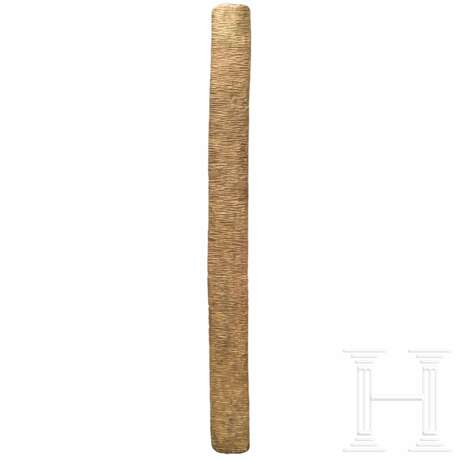14,65 kg schwerer Messingbarren mit drei Stempeln, römisch, 1. Jhdt. n. Chr.
19.11.2024 10:00UTC +01:00
Classic
Starting price
25000EUR € 25 000
| Auctioneer | Hermann Historica |
|---|---|
| Event location | Germany, Grasbrunn / München |
| Buyer Premium | 25 % |
Archive
The auction is completed. No bids can be placed anymore.

ID 1323327
Lot 4116 | 14,65 kg schwerer Messingbarren mit drei Stempeln, römisch, 1. Jhdt. n. Chr.
Monumentaler Messingbarren in Form eines "Bretts" mit abgerundeten Ecken. Höhe 151,8 cm. Breite 14 cm. Stärke 1 cm.
Eine Seite glatt und vom Guss her weitestgehend unbehandelt gelassen, aufgrund des Materialschwunds beim Abkühlen in der Mitte minimal eingesenkt. In der Mitte und ca. 20 cm bzw. 22 cm vom oberen bzw. unteren Ende entfernt drei identische Stempeleindrücke eingehämmert: C - PETRON - HERME. Die Inschrift ist wohl folgendermaßen aufzulösen: C(aii) Petron(ii) Herme(tis). Sie verweist auf den Besitzer bzw. den Hersteller des Barrens. Die Stempelung beweist eindeutig die römische Zeitstellung des Barrens. Die andere Seite auf der Oberfläche vollflächig mit horizontalen Riefen versehen, die quer zur Längsrichtung des Barrens verlaufen. Diese Riefen geben ein Muster wieder, das zuvor in der Unterseite der (tönernen?) Gussform angebracht worden ist. Die leicht versetzt angebrachten Riefen geben trotz leichter Unregelmäßigkeit der Oberfläche auf dieser Seite eine harmonische und wohlproportionierte Textur, welche dem Objekt regelrecht die Anmutung einer "modernen Skulptur" geben.
Der Barren, der einerseits als Technikum ein hochinteressantes Denkmal römischer Industrie ist, kann lösgelöst von diesem Kontext zugleich als Artefakt von hoher ästhetischer Ausstrahlungskraft betrachtet werden. Der Barren wurde wohl schon vom Vorbesitzer gründlich gereinigt und von allen Oxyden und Auflagen befreit, sodass er heute in seinem ursprünglichen Erscheinungsbild mit glänzender metallischer Oberfläche betrachtet werden kann. Ein nahezu identisches Stück mit weitestgehend entsprechenden Maßen und Gewicht wurde 2015 in Auktion 235 bei Gorny und Mosch versteigert und für 30.000 Euro zugeschlagen (Los 56). Dem damals als Unikum zu betrachtenden Barren ist somit ein typgleiches Exemplar zur Seite gestellt. Die wenigen sonst bekannt gewordenen Messingbarren römischer Zeit sind mit diesen beiden Stücken nur bedingt vergleichbar. Der bei Gorny und Mosch versteigerte Barren wurde von P. Rothenhöfer 2015 in der Zeitschrift Gephyra 12, S. 231 - 237 aus wissenschaftlicher Sicht gewürdigt.
Provenienz: Süddeutsche Privatsammlung (nachgelassen) eines Antikensammlers, von diesem in den 80er Jahren aus einer rheinischen Privatsammlung eingetauscht.
A Roman 14.65 kg brass ingot with three stamp impressions, 1st century A.D.
A Roman 14.65 kg brass ingot with three stamp impressions, 1st century A.D.
A monumental brass ingot in the shape of a "board" with rounded corners. Height 151.8 cm. Width 14 cm. Depth 1 cm.
One side smooth and left largely untreated during casting, slightly indented in the centre due to the loss of material when cooling. Three identical stamp impressions: C - PETRON - HERME hammered in the centre and approx. 20 cm and 22 cm from the upper and lower ends respectively. The inscription may probably be interpreted as C(aii) Petron(ii) Herme(tis), referring to the owner or the manufacturer of the ingot. The stamp clearly proves that the ingot dates from the Roman period. The other side of the surface is entirely covered with horizontal grooves running transversely to the longitudinal direction of the ingot. These grooves reproduce a pattern that was previously applied to the underside of the (clay?) mould. The slightly offset grooves present a harmonious and well-proportioned texture, despite the slight irregularity of the surface on this side, which gives the object the appearance of a positively "modern sculpture".
The ingot, which, on the one hand, is a highly interesting testament to Roman industry in technical terms, can, by the same token, also be considered an artefact of high aesthetic beauty. The ingot has already been thoroughly cleaned, presumably by the previous owner, thereby removing all oxides and appliqués, so that its original appearance can be seen today with its shiny metallic surface. A virtually identical piece, with roughly the same measurements and weight, was sold by Gorny and Mosch in Auction 235 in 2015, fetching 30,000 euros (lot 56). Consequently, this appears to be a companion piece to the first ingot, at that time considered unique. The few other documented brass ingots dating from Roman times may only be compared to a limited extent with these two pieces. The ingot sold by Gorny and Mosch was acknowledged from a scientific point of view in 2015 by P. Rothenhöfer in the journal Gephyra 12, pp. 231 - 237.
Provenance: South German private collection (bequeathed) of an antique collector, exchanged by him from a private Rhenish collection in the 1980s.
Condition: I - II
| Place of origin: | Roman Empire |
|---|
| Place of origin: | Roman Empire |
|---|
| Address of auction |
Hermann Historica Bretonischer Ring 3 85630 Grasbrunn / München Germany | ||||||||||||||
|---|---|---|---|---|---|---|---|---|---|---|---|---|---|---|---|
| Preview | |||||||||||||||
| Phone | +49 (0)89 5472 649 0 | ||||||||||||||
| Fax | +49 (0)89 5472 64999 | ||||||||||||||
| Buyer Premium | 25 % | ||||||||||||||
| Conditions of purchase | Conditions of purchase | ||||||||||||||
| Business hours | Business hours
|


